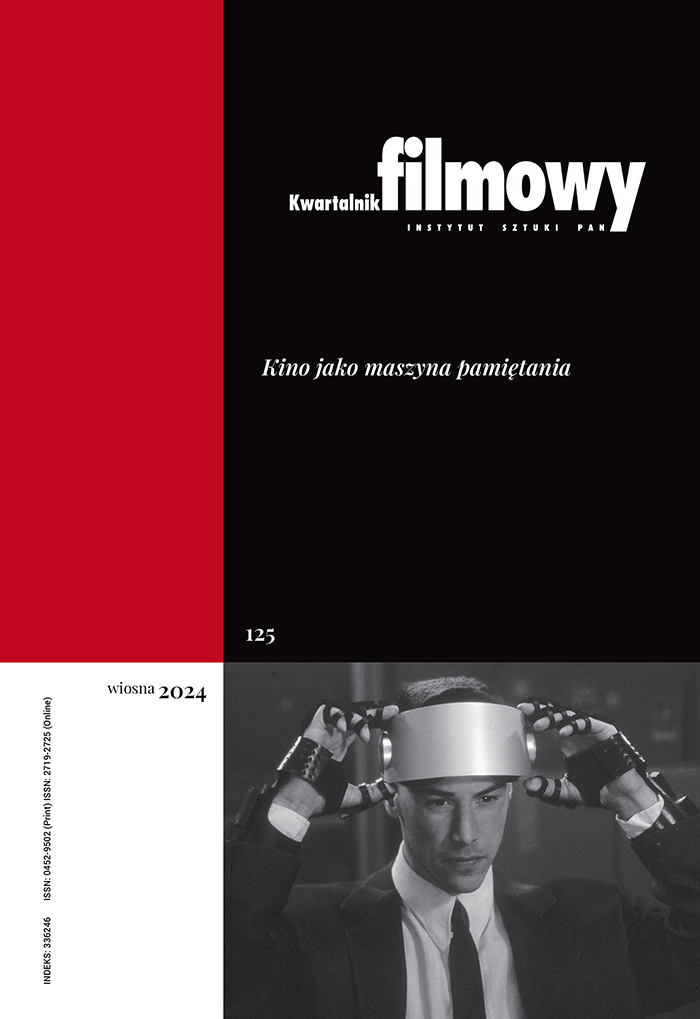(Post)traumatyczne oscylacje. Wstępna eksploracja pewnej dynamiki afektywnej
Klaudia Rachubińska
klaudia.rachubinska@ispan.plInstytut Sztuki, Polska Akademia Nauk (Polska)
https://orcid.org/0000-0002-8240-0643
Abstrakt
Ostatnie dekady przyniosły wzrost zainteresowania traumą, zarówno jako przedmiotem badań, jak i tematem w filmie i kulturze popularnej. Duża część współczesnego kina (zwłaszcza głównego nurtu), koncentruje się na tym, jak trauma kształtuje historię postaci. To podejście redukcjonistyczne, ustawiające traumę jako narzędzie fabularne, zastępujące zniuansowany rozwój postaci uproszczonym „wątkiem traumy”. Reżyserka Lynne Ramsay proponuje inne podejście: przedstawia postaci, które doznały traumy i zgłębia ich doświadczenia nie tylko przez narrację, ale też unikatowy styl filmowy. W artykule autorka wykorzystuje strukturę zaproponowaną przez Jill Bennett do analizy obrazów traumy, aby zbadać, jak formalne elementy filmu Musimy porozmawiać o Kevinie (2011) odzwierciedlają (post)traumatyczne doświadczenie przez dynamikę afektywną określoną mianem oscylacji. Eksploruje także mechanizm uruchamiania przez tę dynamikę trybów empatycznego zaangażowania oraz wytwarzania przez nią w oglądających doświadczenia afektywnego strukturalnie podobnego do traumy. [artykuł opublikowany w języku angielskim jako: (Post)traumatic Oscillations: A Preliminary Exploration of an Affective Dynamic]
Słowa kluczowe:
trauma, doświadczenie (post)traumatyczne, dynamika afektywna, oscylacja, Lynne RamsayBibliografia
Bennett, J. (2005). Empathic Vision: Affect, Trauma, and Contemporary Art. Stanford: Stanford University Press.
DOI: https://doi.org/10.1515/9781503625006
Google Scholar
Caruth, C. (1995). Recapturing the Past: Introduction. In: C. Caruth (ed.), Trauma: Explorations in Memory (pp. 151-157). Baltimore – London: The Johns Hopkins University Press.
Google Scholar
Caruth, C. (1995). Trauma and Experience: Introduction. In: C. Caruth (ed.), Trauma: Explorations in Memory (pp. 3-12). Baltimore – London: The Johns Hopkins University Press.
Google Scholar
Caruth, C. (1996). Unclaimed Experience: Trauma, Narrative, and History. Baltimore – London: The Johns Hopkins University Press.
DOI: https://doi.org/10.1353/book.20656
Google Scholar
Forter, G. (2007). Freud, Faulkner, Caruth: Trauma and the Politics of Literary Form. Narrative, 15 (3), pp. 259-285.
DOI: https://doi.org/10.1353/nar.2007.0022
Google Scholar
Pederson, J. (2018). Trauma and Narrative. In: J. R. Kurtz (ed.), Trauma and Literature (pp. 97-109). Cambridge: Cambridge University Press.
DOI: https://doi.org/10.1017/9781316817155.008
Google Scholar
Seghal, P. (2021, December 27). The Case Against the Trauma Plot. The New Yorker, https:// www.newyorker.com/magazine/2022/01/03/the-case-against-the-trauma-plot
Google Scholar
Self, W. (2021). A Posthumous Shock. Harper’s Magazine, https://harpers.org/archive/2021/ 12/a-posthumous-shock-trauma-studies-modernity-how-everything-became-trauma/
Google Scholar
Sütterlin, N. A. (2002). History of Trauma Theory. In: C. Davis, H. Meretoja (eds.), The Routledge Companion to Literature and Trauma (pp. 11-22). London – New York: Routledge.
DOI: https://doi.org/10.4324/9781351025225-1
Google Scholar
Thornham, S. (2013). ‘A Hatred so Intense…’ We Need to Talk about Kevin, Postfeminism and Women’s Cinema. Sequence: Serial Studies in Media, Film and Music, (2.1), pp. 3-36.
DOI: https://doi.org/10.20919/sequence2.1(2013)
Google Scholar
Vaage, M. B. (2010). Fiction Film and the Varieties of Empathic Engagement. Midwest Studies in Philosophy, 34 (1), pp. 158-179.
DOI: https://doi.org/10.1111/j.1475-4975.2010.00200.x
Google Scholar
Autorzy
Klaudia Rachubińskaklaudia.rachubinska@ispan.pl
Instytut Sztuki, Polska Akademia Nauk Polska
https://orcid.org/0000-0002-8240-0643
Badaczka filmu i kultury wizualnej, absolwentka Wydziału Psychologii oraz Instytutu Kultury Polskiej Uniwersytetu Warszawskiego. Zatrudniona w Zakładzie Filmoznawstwa, Sztuk Audiowizualnych i Antropologii Kultury w Instytucie Sztuki Polskiej Akademii Nauk. Od 2022 r. redaktorka „Kwartalnika Filmowego”, w latach 2018-2021 sekretarz redakcji internetowego czasopisma naukowego „Pleograf. Kwartalnik Akademii Polskiego Filmu”, członkini Polskiego Towarzystwa Badań nad Filmem i Mediami. Laureatka XXIII Konkursu o Nagrodę im. Krzysztofa Mętraka. Pracuje nad rozprawą doktorską poświęconą wizerunkom kobiet w muzyce rozrywkowej.
Statystyki
Abstract views: 476PDF downloads: 355
Licencja
Prawa autorskie (c) 2025 Klaudia Rachubińska

Utwór dostępny jest na licencji Creative Commons Uznanie autorstwa 4.0 Międzynarodowe.
Autor bądź autorka udziela wydawcy niewyłącznej i nieodpłatnej licencji (CC BY 4.0) na wykorzystanie tekstu w „Kwartalniku Filmowym”, zachowuje nieograniczone prawa autorskie i zobowiązuje się do podawania miejsca pierwodruku przy ponownym wykorzystaniu artykułu (umowa licencyjna do pobrania). Czasopismo jest wydawane na licencji CC BY 4.0. Zgłaszając artykuł do publikacji, autor bądź autorka wyraża zgodę na jego udostępnianie na tej licencji.
W wydaniach od 105-106 (2019) do 119 (2022) wszystkie artykuły były publikowane na licencji CC BY-NC-ND 4.0. W tym okresie autorzy i autorki udzielali(-ły) niewyłącznej i nieodpłatnej licencji (CC BY-ND 4.0) na wykorzystanie tekstu w „Kwartalniku Filmowym”, zachowywali(-ły) nieograniczone prawa autorskie i zobowiązywali(-ły) się do podawania miejsca pierwodruku przy ponownym wykorzystaniu artykułu.
Inne teksty tego samego autora
- Klaudia Rachubińska, Filmowe spotkania z ciałem , Kwartalnik Filmowy: Nr 128 (2024): Dekolonizacja dyskursów filmowych
- Klaudia Rachubińska, „No Time, Make, or Reason”. Afektywne formy teledysku „Only You” zespołu Portishead , Kwartalnik Filmowy: Nr 123 (2023): Tempo i rytm
- Klaudia Rachubińska, „You're one of me?" Ciało jako nośnik tożsamości w filmach Davida Cronenberga , Kwartalnik Filmowy: Nr 83-84 (2013): Ciało w filmie
- Klaudia Rachubińska, Nieludzkie, arcyludzkie. Wnętrze ciała w twórczości Davida Cronenberga , Kwartalnik Filmowy: Nr 79 (2012): Wnętrza. O filmowej przestrzeni zamkniętej











